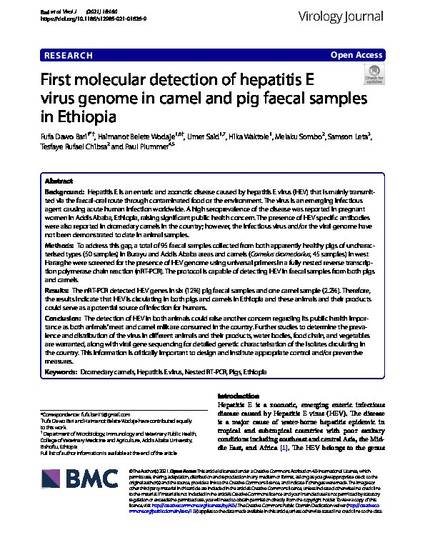
Background: Hepatitis E is an enteric and zoonotic disease caused by hepatitis E virus (HEV) that is mainly transmitted via the faecal-oral route through contaminated food or the environment. The virus is an emerging infectious agent causing acute human infection worldwide. A high seroprevalence of the disease was reported in pregnant women in Addis Ababa, Ethiopia, raising significant public health concern. The presence of HEV specific antibodies were also reported in dromedary camels in the country; however, the infectious virus and/or the viral genome have not been demonstrated to date in animal samples.
Methods: To address this gap, a total of 95 faecal samples collected from both apparently healthy pigs of uncharacterised types (50 samples) in Burayu and Addis Ababa areas and camels (Camelus dromedarius, 45 samples) in west Hararghe were screened for the presence of HEV genome using universal primers in a fully nested reverse transcription polymerase chain reaction (nRT-PCR). The protocol is capable of detecting HEV in faecal samples from both pigs and camels.
Results: The nRT-PCR detected HEV genes in six (12%) pig faecal samples and one camel sample (2.2%). Therefore, the results indicate that HEV is circulating in both pigs and camels in Ethiopia and these animals and their products could serve as a potential source of infection for humans.
Conclusion: The detection of HEV in both animals could raise another concern regarding its public health importance as both animals’ meat and camel milk are consumed in the country. Further studies to determine the prevalence and distribution of the virus in different animals and their products, water bodies, food chain, and vegetables are warranted, along with viral gene sequencing for detailed genetic characterisation of the isolates circulating in the country. This information is critically important to design and institute appropriate control and/or preventive measures.
Available at: http://works.bepress.com/paul-plummer/45/

This article is published in Virology Journal. DOI: 10.1186/s12985-021-01626-9. Posted with permission.